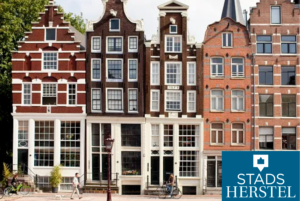
August 10, 2022 Exploring the world of preservation: Historic building conservation models, near and far
Christopher Impellizeri hails from West Roxbury and is a rising junior at DePaul University in Chicago, studying urban planning and development. As HBI’s summer 2022 intern, Chris has been working on several projects, among them research on non-profit organizations near and far that, like Historic Boston, undertake the rehabilitation of historic buildings that are at-risk for new uses. Chris offers us a taste of this research here and what he’s learning.
Hey folks, Chris the intern here!
For my first blog post for HBI, I wanted to take the opportunity to talk about some of the things I’ve learned from a variety of wonderful historic preservationist societies across the country and around the globe!
But why do this in the first place? As the needs of the city change, HBI is looking outward for ideas on how to better protect Boston’s past for the sake of the future. Part of my role here this summer is to assist HBI in this ongoing process. So far I’ve done a deep dive into four distinct organizations Stadsherstel in Amsterdam, the Norwich Preservation Trust in the UK, the Springfield Preservation Trust in Massachusetts, and the Great Yarmouth Preservation Trust:
Stadsherstel (City Recovery), Amsterdam:
Founded in 1956 by a collective of local artists, architects, and politicians following intense urban decline within the historic city center, Stadsherstel seeks to provide for increased housing demands through the repair, modernization, and management of historic houses. Stadsherstel owns, manages, and leases over 750 historic, previously at-risk properties with the aid of local crafts training programs, volunteers, and grants. Some are standard residential/ commercial structures, while others are elaborate castles or quaint windmills. Each building is restored with the intention of re-use and environmental sustainability.
Norwich Preservation Trust, UK:
The NTP has been providing preservation consultation and development assistance services since 1966. The so-called “restorer of last resort” has rehabbed over 20 structures of special interest by the Historic Building and Monuments Commission for England (aka Historic England). They hope to continue the restoration of historic homes and businesses across Norwich.

![]()
Springfield Preservation Trust, MA
Much closer to home, SPT was founded in 1972 by residents in response to historic buildings being rapidly demolished. Once an active buyer, restorer, and seller of several decomposing properties, SPT now provides local and future Springfield residents/ business owners with a wealth of educational resources on how to best rehabilitate, adaptively re-use, and maintain the town’s historical structures. They also provide a series of workshops and walking tours available to members and the public alike.
Great Yarmouth Preservation Trust, UK
Since 1979 the GYPT has sought to “acquire at-risk heritage assets to restore their economic viability, management, and long-term maintenance for the sake of preserving, safeguarding, and promoting cultural heritage”. Thus far the trust has successfully carried out its mission, completing 27 projects of exceptional interest to Historic England, and removing 12 buildings from the English Heritage Risk Registry. A large volunteer and specialty craft contractor network allows GYPT to continually provide restoration assistance to the Great Yarmouth community.
![]()
![]()
Below are some of the key takeaways I’ve gathered so far:
- Preservation organizations balance form and function. Stadsherstel, for example, divides properties between those that are more culturally significant (but less economically sustainable) and those that can serve the developing needs of Amsterdam, whether it be as rehabbed low-income housing, event space, or something more!
- These organizations rely just as much on their skills as they do on that of the community. Each of the four preservationist groups foster training workshops to equip locals with the knowledge and skills to continue the artistry of historic preservation. Some, such as GYPT and Stadshertsel, collaborate with local trade schools and job development initiatives to give people more professional experience. Others, like the SPT and the NPT, host DIY workshops for home and business owners on everything from basic historic window maintenance to furnishing repair. Regardless of the approach, each organization cultivates a powerful relationship with the community, developing a communal sense of ownership amongst community members for their unique historic fabric!
- Community input is key. All of the organizations I’ve studied so far were born out as a response to large commercial developers or aggressive city planners ignoring the needs and wants of others. In response, these groups came together to actively engage with community members. Today, the relationship between organization and community remains an integral part of any act of preservation.
The interaction between the two doesn’t have to be limited to just public seminars and comment periods. Take, for example, our neighbors in Springfield. The Trust’s official website maintains comprehensive lists of known at-risk historical buildings, preservation “wins” (successful preservation projects, local ordinances in favor of preservation, etc.), lost historic structures, and trusted private contractors. They also host a yearly preservation award ceremony where the organization acknowledges exceptional examples of historic preservation across the community.
In Great Yarmouth, citizens can submit buildings of interest to the local preservation trust, along with ideas for re-use and rehabilitation. The result in both cases is an engaging and collaborative approach to ensuring the towns and cities we call home keep their historic character for years to come.
So, what comes next for HBI?
I still have some ways to go before my investigation wraps up, but in the meantime, I’d love to know your thoughts! Were there any community resources mentioned above that you’d like HBI to provide, like an at-risk list informed by readers like you? Feel free to drop me a message at chris@historicboston.org!
In the coming weeks, I’ll be sure to drop even more info about historic preservation around the world, as well as other exciting HBI projects!
Chris Impellizeri



